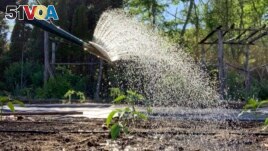05 July 2021
Gardeners cannot always tell how much rain has fallen. Your garden area may seem completely wet after a strong, short period of rain. But if you put your finger a short way into the ground, you might find very dry soil.
Because watering - not too much and not too little - is one of the keys to a successful garden, it helps to get more information about rainfall.
As a general rule, plants need about 25.4 millimeters of water per week for healthy growth. You can easily measure this with a rain gauge, which you can either buy or make at home out of nothing more than a coffee can or some other can, and a measuring stick.

This undated photo shows water leaving a watering can in New Paltz, NY. (Lee Reich via AP)
Electronic gauges will also tell you the amount of rainfall or the depth, in millimeters.
A rain gauge can tell you how long to water to put the desired amount of water onto the garden. It is best to water most plants, like tomatoes, at their root and in the morning, before the sun has become hot. Any water that falls directly on your plants will dry during the day and you will not have the problem of plant diseases or growth of harmful organisms. When you can, water your garden slowly so the liquid can go deeper in the soil.
How to make a simple rain gauge
If you use a device like a sprinkler, you can measure the water falling on the garden with a homemade gauge. Collect a few empty soup cans or plastic containers and clean them. Then, use a permanent marker and your measuring stick to mark a line 25.4 millimeters high around the inside of the container. If you live in a place with much rain, mark again at 50 mm. Because the water might not fall equally, set out a few cans here and there over the area to be watered. Then turn on the sprinkler until the cans have the water up to the line. Be sure to empty the cans after you water or when it has rained to prevent mosquitoes from laying eggs in the water.
If you usually water with a bucket or watering can, use the 25 mm measure to determine the amount needed for the area of your garden.
To measure your garden area, multiply the length of the shortest side of your garden by the length of the longest side. This will give you the area.
Each week, the desired amount of water should be about 2.5 liters per square meter.
With a watering can, it is easy to see how much water you are using. If you use a hose, compute its output over time, then calculate how long you have to stand there to get sufficient water for the area you are watering. It probably is longer than you expected.
This watering guideline is for soil that has not dried out too much. If the soil is very dry because you have not watered it, or because it has not rained, for three weeks, you have to get it completely wet first. Then, a week later, give it your desired amount of water.
Not all plants need the same amount of water
This watering rule is for plants whose roots are mostly in the upper 30 cm of soil, which includes most annual vegetable and flower plants. Plants with roots deeper than 30 cm need more water; corn roots, for example, run about a meter deep. It is especially important to water trees and woody plants well in their first season.
Not all plants have the same water needs. Read about your favorite plants and then watch your plants and feel the soil around them. Use a small garden tool to check the soil about a hand length under the surface. Tomato plants need about 50 mm of water a week, while peppers are happy in drier places. Plants in containers may dry out much faster than plants in the ground.
A rain gauge will tell you if a summer storm dropped so much water that you can forget watering for a week, or if what you thought was a hard rain was just a 6-mm sprinkling. If you get only six millimeters of rain, the remaining 19 mm, or two liters of water per nine square meters, will have to come from your hose or watering can.
I'm Jill Robbins.
Lee Reich reported on this story for the Associated Press.
Jill Robbins adapted it for Learning English. Caty Weaver was the editor.
Words in This Story
sprinkler – n. a device that is used to spray water on plants or soil
sprinkling – n. a light rain
gauge – n. an instrument that is used for measuring something
hose – n. long, usually rubber tube that liquids or gases can flow through
calculate – v. to find (a number or answer) by using mathematical processes
How do you learn about how much rain falls where you live? Write to us in the Comments Section.












